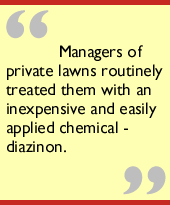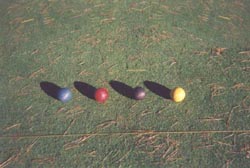

|
Back to |
| The Front Page |
| News & Features |

|
The Mudsucker Miracle
by Bob Alman Posted April 21, 2000 |
|
||||
When you have a croquet lawn to care for, there is always something to do next. Usually your management priority presents itself as some kind of problem - an unwanted condition you have to find a way to remedy.
The practice of sport and religion have much in common, especially on Sunday morning at the croquet lawns, in a cathedral of bordering trees and arching sky, carpeted with a perfect monoculture tended with sacramental devotion. Sport comes nearest to religion when the earth is renewing itself, the grass awakes from its winter torpor, and all the turf-loving critters emerge at once: croquet players, gophers, moles, teenage vandals, and - in the dead of night, when nobody can prevent it - a particularly vile underground species which comes unpredictably to deposit little mounds of sticky mud on the lawn, spoiling good strokes and soiling white cuffs. Something must be done - but what? The challenge can be considerable for a lawn manager in an environmentally restricted zone. Insurmountable, perhaps. Needing nothing less than a miracle. Here is a mostly true story about croquet lawn management, tailor-made for the season of miracles.
Not long after one of our municipal club lawns was rebuilt, we had to confront one such problem - a plague of night crawlers.
It was that bad. We would come out in the morning and confront hundreds of mounds of dirt an inch high all over the lawn. If there had been rain the night before, the problem would be especially messy. Rain brings them to the surface, apparently, and they leave behind mounds not of dirt, but of sticky mud.
No obvious or easy remedy presented itself. The best we could do was to rake the mounds flat, spreading them out over the surface and making an unsightly mess. We could play on it, but not with any great sense of pleasure.
We asked the gardener about a chemical remedy - a final solution that would handle a long-term problem. He said he would check on it, then came back a week later and told us nothing could be done. This night crawler activity was actually good for the grass, according to his supervisor. "It might be good for the grass, but it's not good for croquet," we said. He shrugged. He worked for a public bureaucracy. He had to follow the rules. He had no choice.

We independently checked with managers of private specialty lawns in the area. We found out that they all routinely treated their lawns to avoid this problem with an inexpensive and easily applied chemical - diazinon.
We went back to the gardener. "Please apply diazinon," we asked, "because that's what everyone does, and it works, no problem." The gardener said he would check with his supervisor.
Soon the word came back down the hierarchy: Regulations forbid the application of diazinon on park lawns.
This made no sense. Surely, we said, this regulation is not meant to apply to a specialty facility designed to provide a flat and unblemished surface for croquet on lawns encircled by protective fences...? The regulation was clearly intended for OPEN space, not for specialty greens. EVERYONE uses diazinon routinely for this problem! The gardener shrugged again. "We have to follow regulations."
We went directly to the supervisor. We got the same story at the next level of the bureaucracy, and the next, and the next. The regulation is designed to protect the public, they said. The regulation makes no distinction between open, bluegrass spaces, dog runs, boulevard medians, children's playgrounds, picnic areas, or croquet lawns. Regulations are regulations. End of story.
No solution. As de facto lawn manager, I had run out of options. I had encountered a problem that could not be managed. I hate it when that happens! It violates my private canon of management, my belief that every problem can be managed, if only one finds a way. But not this one.

Nevertheless, I checked out my local garden supply store to see if the chemical were available, and what kind of environmental restrictions were placed on its use. I confirmed that the chemical is an "over-the-counter" remedy, cheap, easily applied, with safety regulations involving little more than following simple directions and common sense.
Theoretically, we could buy the chemical and applicator, put it down, and handle the problem in a couple of hours at most. But that would be wrong. That would make us criminals, thwarting the public will.
There was no way out. I had to report to my board that after everything we had done to create playable lawns, after all the obstacles we had hurdled - vandalizing golfers, summer burnout, fungus, gophers, teenagers on motorbikes - we had at last met our masters: the lowly, mudsucking night crawlers.
"As someone who is supposed to be a manager, " I confessed, "and not particularly religious, I don't like telling you this. But it looks like there's nothing we can do about the night crawlers except to hope and pray the problem goes away. That's about it."
It was a sobering moment. We had worked so hard and so well. Despite all the odds, we had persuaded the City to build two lawns for croquet, unprecedented in the entire country. They weren't very good, at first, but we were on a steady course of incremental improvement. And now this. A long silence engulfed the meeting.
Finally, one board member asked, "Exactly what are we supposed to hope for?"
Another said, "We could pray that the night crawlers catch some terrible disease that decimates their population..."
"Oh, that's terrific," another said sarcastically. "All we have to do is wait for a spontaneously mutated virus to come along and attack the little mudsuckers..."
"Or that some predator of night crawlers miraculously saves us...You know, like the seagulls in Salt Lake City saved the Mormons...?"
We brainstormed in this vein for some time, going down the list of possibilities, all of them unlikely, some of them silly. Someone even suggested that a criminal could come along in the dead of night, applicator in hand, and put diazinon on the lawns. Some kind of anarchist. Lots of nut cases wander around the public parks, it could happen! It was a slim hope - that a psycho with the precise mental loose screw that could coincidentally solve our problem might happen by in our time of need.
Another board member opined that it wouldn't have to be a crazy person or a truly bad person, either. It could be someone who had been oppressed by the government, a kind of Robin Hood who heard of our plight and knew, as we knew, that the bureaucracy's regulation was not appropriate in our case. A person like that might conceivably go and buy the diazinon and in a righteous rage spread it around on the croquet lawn WITHOUT AUTHORIZATION in the dead of night - as blow for justice and liberty!

After all our work, investigation, research, brainstorming, we were exactly nowhere. We were left, as far as our ability to manage the problem was concerned, with this wimpish prescription: "We will just hope and pray. Because there is nothing else that we can do."
What happened next cannot be placed in time or logic. It is beyond understanding. It cannot be explained. A miracle happened.
Within a month of our group determination that nothing could be done except to hope something happened, those little mudsuckers began to disappear. And we haven't had a night crawler problem since!
Of course, we have no idea what happened or how it happened. That is the nature of miracles. We never discussed it with the gardener, or with any of the park and rec staff. What would be the point? What could anyone say about a miracle?
What, indeed, is the point of this story? Only to acknowledge that, as a manager, sometimes there is absolutely nothing you can do. This is contrary to the folk wisdom that says, "Everything can be managed; where there's a will, there's a way; if at first you don't succeed, try, try again..."

|
| Morning breaks over a green lawn lightly garnished with pine straw - and no sign of the night crawlers. |
The ultimate test of a manager is the ability to be responsible for outcomes beyond the manager's control. The more successful you are as a manager, the sooner you will be faced with the challenge of managing the unmanageable. And you actually can do that.
It's almost a contradiction...but not quite. And here's the best part about "Prayer as a management technique": Whenever you fail in a management challenge, you are going to be asked to explain your failure, in exhaustive detail. But if you succeed by a miracle, no one is going to put you on the spot. No one is going to demand an explanation. Your result is going to be accepted, without question, and with gratitude.
Remember: You're a manager. What a manager does, is manage. Your results, your reputation, your self-image all depend on getting the thing done. So if nothing will work except a miracle...go for it!
|
A note on diazinon and the politics of regulation |
Some years ago, diazinon was linked with the mass death of a flock of Canadian geese on a golf course in the Northeastern United States. Some environmental groups politicized the issue, public outrage was aroused, and the application of diazinon in any form, granular or liquid, over large areas - such as golf courses - was banned, before any significant studies were done.
According to Dr. Carl Mabee, Chairman of the USCA Courts and Greens Committee, who lives in the region where the extermination occurred, waterfowl such as Canadian geese are particularly sensitive to diazinon. They are turf eaters, strongly attracted to large greens expanses like golf links. Canadian geese make an incredible mess on golf links, and may sometimes hang around on them all winter. They hiss and sometimes attack golfers, and they steal golf balls. The rumor that the bird kill resulted from an intentionally large dose is therefore understandable.
After the manufacturer, Ciba-Geigy Corporation, adjusted the recommended dosage and changed the form of the chemical, the company appealed to the EPA for a judicial review and won their case. However, a new EPA director, perhaps succumbing to political pressures, overturned the judge's ruling and again outlaws the use of the chemical in any form over large areas. The ruling implanted itself within public bureaucracies.
The law does not apply to home applications of over-the-counter portions of diazinon. And oddly enough, other insecticides known to be more powerful and deadly than diazinon are legal.
The history of the diazinon ban suggests that many of the regulations and laws on environmental matters are based, not on facts or scientific studies, but on emotional responses to publicity.
This story is adapted from an article in the Croquet Foundation of America's MONOGRAPH SERIES ON CLUB-BUILDING, ORGANIZATION, AND MANAGEMENT, Volume Two, "Organizing for Success", published in 1994.